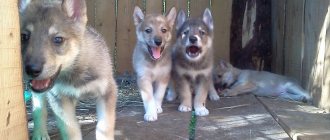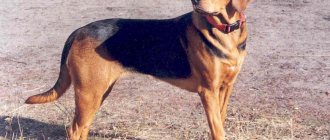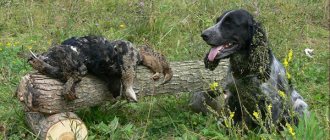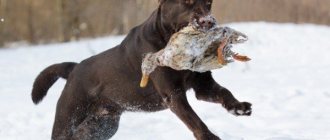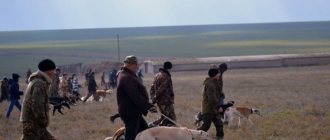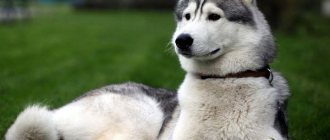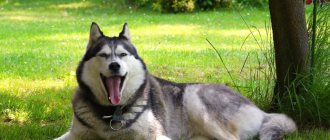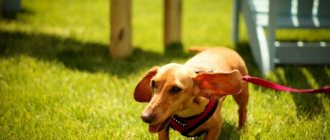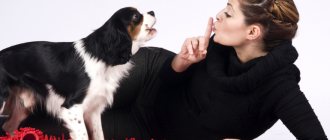- September 3, 2018
- Dogs and hunting with them
- Oleg Petrov
Training huskies is a difficult and responsible task. You need to carefully approach the choice of a dog, its pedigree, ask the breeders about the characteristics of its health, whether there are any special conditions for its maintenance and training. Buying a Laika puppy from you should not be difficult, since this is a very common breed. First he needs to prepare a corner in a new place, which will be specially designed for him.
Breed Features
Training huskies is not an easy process, but anyone can do it if you strictly follow the instructions and directions. The ideal place to live for any hunting dog is the street. So this breed is, first of all, suitable for those who live in a private house. The puppy can be placed in the most ordinary wooden booth in a closed enclosure. This is very convenient because the dog will not sit on a leash, but at the same time recognizes its territory. If in the future you plan to take your husky with you hunting, then you need to train it on a specific animal.
Laika training for hunting must be carried out, taking into account that this is a very independent and freedom-loving breed. They are very inquisitive and during a walk they can run far from their owner in order to explore a new territory, get carried away by the surrounding dogs during this time and even get lost. Unfortunately, these unpleasant situations happen quite often with likes.
With their external characteristics, hunting huskies compare favorably with many other dogs due to their beauty, grace, large fluffy tail, which rolls in a roll, as well as bright coloring. The weight of an adult dog varies from 20 to 30 kg, and its height on average reaches 60 cm at the withers.
An adult hunting husky can always be distinguished by its ears, which are in an erect position, thick hair in the “collar” area, an elegant figure, an oval head, and a strong build.
Hunting qualities
Laikas are often used in hunting due to their outstanding qualities and special physical characteristics. This breed has a very well developed sense of smell, which it uses to find prey. Thanks to her sense of smell, she is able to detect the smell of future prey approximately 100 meters from the source. In addition, these dogs have very well developed hearing; they can hear a person sneaking 100 meters away.
Professional hunters divide the Laika breed into three varieties. These are hounds - dogs that follow the trail of an animal and primarily use their sense of smell when hunting. There are also spirit huskies, which, in addition to their sense of smell, include a rare natural hearing, thanks to which they very clearly determine where the prey will come from and head in that direction. Low-sense animals are susceptible to the smell of animal tracks; they walk along them, sniffing, practically without raising their heads.
The husky dog has sense of smell - an innate quality. The owner only needs to do everything possible so that it does not weaken. For example, damage can be caused by arranging repairs in the immediate vicinity of its habitat. Due to the strong smell of chemicals (varnish, paint), her senses can be seriously weakened. Therefore, if there is an urgent need to carry out repairs, the husky needs to be relocated for this time.
In addition, dogs of the Laika breed are able to search for prey very quickly. It can be constantly developed by training and coaching the dog. This quality increases depending on how physically prepared and developed the husky is. For example, when a puppy suffers from rickets, it should not be taken for a long walk so that it can recover. Training huskies to quickly search for prey is instilled in the puppy from the age of 5 months.
The husky has a sonorous and loud voice that can be clearly heard throughout the forest. To preserve it, you need to teach the puppy to remain alone from childhood, so that in the future he will not lose his voice when he sits on a chain. You should also take care of the collar, which should be the right size and not tighten the throat. So, the hunter will be able to find hunted prey, focusing on the barking of his dog. This is another quality that is formed in the process of training a husky.
Hunting dogs' tracking of prey is divided into ground and mounted. When hunting, you need to take both types - both when the prey moves on the ground and when it runs away through the trees.
When training a husky puppy, it is important to cultivate such a quality as viscosity. They develop only as a result of long training. Dogs with good viscosity search for an object, chase it and bark until the owner gives the appropriate command. Otherwise, they will stop barking whenever they please.
It is important that the dog obeys all commands without question. This quality needs to be cultivated when training a husky puppy. She must return upon request, otherwise a fruitful hunt will not work.
It is important that the dog is restrained towards the caught prey. She should not run with the caught object, gnaw or throw it, tear it with her teeth or refuse to give it to the hunter.
Finally, another important quality is dexterity. The husky will especially need it when hunting large animals. The dog must have an instant reaction, the ability to dodge at the right moment, jump, so as not to turn into a victim of an angry bear or wild boar.
Upbringing
Training a husky at home needs to start with proper upbringing. This is a very important point. The dog must be vaccinated, eat well, and be outdoors often. A dog can be trained to wear a collar from the age of 3 months.
One of the primary tasks for the owner is choosing the right nutrition. Initially, you need to decide whether you will feed your dog dry food or prepare it yourself.
Experienced experts advise feeding your puppy 6 times a day until he is 6 months old, and then reducing the number of meals to those times. It is enough to feed an adult dog twice a day. It is very important to pay due attention to water. It should always be clean and fresh, it should be changed at least three times a day.
The husky must eat meat every day. It is preferable to opt for beef, chicken, rabbit or turkey. A couple of times a week, fish may be included in the diet as a treat. She also needs dairy products - sour cream, cottage cheese, yogurt, milk.
Dairy products significantly diversify your pet's menu. From time to time it is advised to give a raw egg, fresh vegetables and fruits. Spicy and fried foods, potatoes, pasta, legumes, expired or spoiled foods are strictly prohibited.
Feeding your pet
Foods that people eat are not suitable for dogs. Their diet includes fish, meat, milk, kefir, cottage cheese, porridge, vegetables, vitamins and minerals.
The composition of the feed is regulated so that it contains all the microelements necessary for the development of the body. After purchasing puppies, breeders recommend sticking to the same diet.
The feeding principle is determined by age:
- 1-2 months – small portions 5-6 times a day.
- 2-5 months – 4 times.
- 5-10 months – 3 times a day.
- Adult dogs are fed 2 times a day.
They cannot eat fatty meat and bird bones. Solid fragments can damage the intestines; fat causes digestive problems.
The Russian-European Laika is unpretentious to food; its strong stomach requires variety in its diet; young individuals are not given fresh meat. Before serving, heat treatment is performed to get rid of helminths. It is recommended to use beef, sea fish fillet; bones supply the body with calcium. Portions are calculated based on the pet's weight, 30% is fed in the morning, 70% in the evening. It is necessary to maintain physical fitness; the appearance of the coat indicates the quality of the diet. To expand the list of vitamins, use bone meal, buckwheat, oats, and vegetables.
Before buying puppies, you need to study the following information:
- Features of the breed.
- Rules of maintenance and care.
- Reviews from parents and owners.
- What affects the cost?
A hunting dog takes a long time to train, they like to walk a lot, they are often taken out into nature, it will be difficult to live in an apartment.
If the parents are satisfied with the qualities, you can choose young animals. Puppies are found through advertisements in nurseries. The breeder will get all the information about the parents, their inclinations, habits, pedigree, etc. If the owner tries to avoid answering, it is better to choose other dogs. You should not take a puppy offered to a breeder without first looking at the other dogs in the litter.
To catch the animal, puppies are suitable; they find the mother's nipple faster than others and make their voice louder. It is not recommended to pay attention to size; other qualities are needed to catch an animal. Hunting instincts are inherent at the genetic level and appear with age in a good dog.
The cost of an animal with documents ranges from 3,000 to 9,000 rubles. Instincts and intelligence deserve the best reviews from many. It is better for dog lovers to get another pet. They are combed 2-3 times a week so that the coat retains an attractive appearance; during shedding, this is done every day, old hairs are quickly replaced with new ones, and hairballs do not appear. Even after treatment with anti-parasite agents, the body is inspected for ticks.
The pet's abilities are suitable for lovers of an active lifestyle. Physical activity is needed regularly. Dogs have no fear, a developed ability to navigate the terrain, a quick reaction, increased good performance, and a playful temperament. Aggression towards other animals is manifested; such qualities make the dog a good hunter. Training allows you to raise police dogs that help catch criminals.
The Russian-European variety is susceptible to insects and ticks, and requires regular treatment with an anti-ectoparasite spray. It is difficult to find a tick due to its fluffy undercoat. Fleas provoke allergies, make you itch, and sometimes worms appear after biting.
Ixodid ticks are sometimes infected with piroplasmosis. Their activity increases from March to June and in the fall until frost. The pet must be treated regularly. Popular means:
- Drops on the skin.
- Spray.
- Pills.
- Flea and tick collar.
If parasites are detected, gloves are put on your hands and the tick is twisted out of the skin with tweezers. The direction of rotation differs among different insects. If you do this incorrectly, the sting will break off and remain inside. The bite site is treated with an antibacterial agent and examined. The four-legged animal’s well-being is monitored for two or three days; activity and good appetite indicate the absence of illness. If symptoms appear, you will need the help of a veterinarian.
Signs of piroplasmosis:
- Lethargy, lack of interest in surrounding objects and phenomena.
- The temperature rises to 39.
- Poor appetite.
- The hind limbs do not work, it is difficult to get up.
- Urine turns red.
- The eyes turn yellow.
Common diseases:
- Bladder stones.
- The voice sits down.
- Epilepsy.
- Allergy.
- Joint dysplasia.
- Obesity.
- Infections and injuries received while hunting.
A booth with straw bedding for insulation is installed in the enclosure. The canopy and wooden floor protect from cold and precipitation. They need to be walked for several hours every day so that their instincts are not lost and their physical fitness is maintained.
If a Russian-European Laika lives in an apartment, arrange the sleeping place away from drafts and warm heaters, and buy several toys. If you accustom your puppy to a crate, you will be able to avoid pogroms in the house.
Basics of training
Training a puppy must begin from the first hours of its presence in your home. If you choose a dog for yourself exclusively as a friend, and not a hunting companion, then it is enough to teach it the basic commands and make sure that it carries them out unquestioningly. First of all, during the game, teach your pet its name.
Then he must master the collar and later the leash. The first command that the husky understands is: “Near!” Over time, teach her to respond to the owner’s voice, the sound of a whistle, and follow the commands “Lie down!” and “Sit!”, bring the desired item. Laikas are also taught to swim in bodies of water through play; the dog cannot be forced into the water.
Laikas should be trained outdoors, ideally in the forest. The dog should definitely be encouraged, but not too flirted with it.
Boar ride with Russian-European husky
A forgotten art is blowing trunks. This way you can call a lost dog or signal the end of the hunt.
Photo by ANTON ZHURAVKOV
I remembered that my dad always observed the dog’s behavior when preparing to hunt. He told me: “Look, Dinga doesn’t want to get up,” and explained that if the dog is lethargic and doesn’t want to get up, then the animal is lying tightly in the forest. Dogs, like wild animals, sense changes in the weather well; they know what will happen - rain or snow.
I told all this to my friend. Indeed, there was a thaw that morning. But we still went into the forest. The dogs perked up and went on a search, but the move was short, and they were visible almost all the time. In general, everything turned out to be predictable: the animal lay down, there were no traces.
Having made a fair circle in vain, we headed towards the house. And then we met two local guys with a survivor. Stopped for a smoke break. It turned out that they had a license for wild boar, and that the animals were a real nuisance to them not only in the summer, but also in the winter. They tear up the silage pits, the silage spoils, and the cattle are deprived of succulent feed. They tear up wild boars and potato piles, and this is really bad, because the potatoes freeze and disappear. In short, one misfortune. So they were given a license to shoot the animal and scare the herd.
- Boys! - they begged. - Help me take the boar. There's a herd of this kind walking around here - it's just a disaster. There is no life for them. We need to scare them. Maybe they'll go somewhere else.
- What questions! Of course we will help! - we agreed.
The guys knew very well the place where the wild boars went for the day, and literally ten minutes later they found a path trodden by the herd. Dinga immediately went along the path, and very soon her ringing voice informed us that the herd had moved.
The guys released the survivor from the pack, and he briskly walked toward the husky’s voice. Kuchum remained with us. And then something unpredictable happened, like the hunt itself.
We ran away. I began to steal away, following the boar's tracks towards the dog's voice, and the rest went around, intending to embrace the herd from all sides. The voice of the survivor was heard, who, it seemed, began to drive. But who? It is clear that it is a wild boar. But which one? He soon lost hearing.
Meanwhile, my father’s omen came true: the weather turned bad and it began to snow. Moving through this snowy mess following Dinga’s voice, I found myself in a tall spruce forest with a clump of young fir trees. The dog was working somewhere nearby, and I stopped, trying to see something ahead. Quite unexpectedly, about thirty or forty meters away, in a gap between the curtains, a pig slipped through, followed by a second one.
When the third appeared, I fired. A heart-rending pig squeal was heard, which really hurt the ears. I didn’t see the result of my shot, but I knew from the squeal that I hit it. There was only one round of buckshot left. I loaded the second barrel with the largest shot - deuce - and went towards the pig's screams with the intention of ending the torment of the beast. Soon I found myself in a small clearing where a pig was spinning on its front legs.
Apparently, the buckshot hit the spine and paralyzed the animal's hind legs. The heart-rending scream attracted not only my attention. As soon as I came out from behind the fir trees and wanted to get closer to the wounded pig, a cleaver came out of the opposite bush to meet me.
Out of surprise, we both froze and stood motionless for several seconds, looking at each other. The cleaver was of impressive size and resembled a huge iron. Good fangs did not bode well.
"What's on his mind?" - a thought flashed. And then the instinct of self-preservation kicked in. I raised my gun and fired. The buckshot seemed to have stunned the boar. He stood still for another second, and then turned around and instantly disappeared. I had nothing to add, and I didn’t need to.
After the second shot, Dinga appeared. Having stopped the torture of the wounded pig, I shouted: “Ready!” and followed the trail of the cleaver. After walking three hundred meters, I was convinced that there was no blood, the animal was moving at good speed. From such a close distance, the grapeshot came in a heap and, obviously, passed a little higher and hit the kalkan without harming the animal. With a clear conscience, I turned back to the abandoned pig. The guys came up to my voice.
It was getting dark. Either snow and rain, or rain and snow fell from the sky. It was disgusting and damp, and it was getting dark quickly. Looking at the dead beast, we exchanged impressions.
“As soon as I heard the first shot and the dog fell silent,” said Volodya, “and then the second one rang out, I realized that the animal had been captured.”
I talked about the meeting with the cleaver and why the second shot was so long delayed, showed where the boar was and where I was. We examined the tracks of the animal and found marks left by buckshot in the snow. It’s good that I overestimated it a little and didn’t harm the boar, otherwise I don’t know how this meeting would have ended for me, because Dinga wasn’t around. I was seriously pounding from belated excitement. Even a cigarette didn’t help, although it took the edge off. Meanwhile, time passed.
- Guys! We need to skin the beast, stop chattering! - I came to my senses. - It will be dark soon.
“We need to light a fire,” someone said, “otherwise we won’t see anything.”
We dispersed in search of dry fuel. We tried to find at least a few dry branches. But it was not there. Even under the mighty spruce it was damp. The small thin branches on it, usually dry, were saturated with moisture. They tried to light the birch bark. But she didn’t want to burn either. All our efforts to make at least a small fire ended in failure. This was the first time this happened to me.
This is where we missed Kuchum. Where did he disappear to? Dinga was nearby. Like a good dog, she curled up in a secluded place, guarding her prey. The guys were calm about the survivor; he was local and would come home. But where is the baby? Volodya was nervous. We shouted, whistled, shot - all to no avail, the dog disappeared into the water.
It got completely dark. The heavenly slush did not stop. We need to do something. We decided to gut the pig, split it in half and move towards the house. The guys navigated perfectly.
They put us on the road, explained which noticeable landmarks we should pass through, which villages we should pass, and which village ours would be. It was eight kilometers to the house.
Having hung our share of the spoils on a pole, we said goodbye and, satisfied with each other, each moved in our own direction. During all this trouble we didn’t even meet, and to this day I don’t know the guys’ names.
Volodya was gloomier than the night had come. How could I calm him down? Words didn't help. The muddy road, which we walked in steps, helped. There was no time for conversation in the complete darkness, and a load of about thirty kilograms was dangling on a pole and constantly trying to throw us either into a rut or into a ravine, of which we encountered plenty on our way.
Anyone who has walked along a Central Russian country road in late autumn, and even in the dark, can imagine our sensations. There was not a light around, complete silence, broken only by our snoring and the squelching of the dirt under our feet. Dinga's shadow flashed ahead.
We passed two villages where two or three windows were lit, but even the dogs did not make a sound, huddling in a warm, dry place. Boots, as they say, know the way, and two hours later we entered “our” village. They were waiting for us. The house glowed with welcoming lights and was visible from afar. Dinga went forward and twirled in the light of the windows at the gate.
Not twenty meters from the house, we saw Kuchum roll out of the darkness towards us. We couldn't believe our eyes! We expected anything, even a meeting with wolves, but not this.
It’s hard to convey how much joy there was when Volodya and Kuchum met. My friend grabbed the dog in his arms, pressed him to him, and he tried to free himself from his embrace, and at the same time, both of them involuntarily burst out some inarticulate sounds. Volodya laughed a happy laugh, constantly repeating: “Kuchum! Kuchum! Look, Kuchum! Where have you been, scoundrel? How did you get here? I thought the wolves ate you!” At the moment of the meeting, there were many other joyful exclamations addressed to the dog, to myself, to me and to someone else. And Kuchumchik, twitching in the owner’s hands, growled and squealed at the same time. The delight was mutual.
A huge stone fell from our hearts, which we carried through the darkness and abyss, sad thoughts dissipated, and fatigue receded.
The day, full of so many events and excitement, ended happily to the satisfaction of all members of our company. Dinga also jumped for joy. It seemed that she understood everything and was pleased with the meeting of friends. At the same time, the dog managed to make a suggestion to the puppy, grumbled at him kindly and, as if inadvertently, tried to wipe him away from the owner.
- Boys! Well, why are you hanging around here? - Matvey Kuzmich asked, coming out to the noise. - And we got so wet. Throw your ammunition into the house! The old woman prepared everything. We've been waiting for you for three hours since the dog arrived!
God! How wonderful it is, after all the excitement, darkness, dampness, hard road and overwhelming fatigue to find yourself in a warm Russian hut, where you are greeted by friendly people! Isn't this happiness? Take off your heavy wet clothes and heavy boots, put on everything dry and soft and completely relax.
There is not a single thought in my head, I don’t even want to eat. But the warmth and comfort emanating from the Russian stove, a sip of beet kvass from a barrel brings us back to life.
Evdokia Semyonovna is busy at the table, hot potatoes, pickles, mushrooms, fried meat and something else tasty appears. And although we weren’t big drinkers, at that moment we regretted that we didn’t have booze. But Matvey Kuzmich rose to the occasion, and a bottle of moonshine appeared on the table. How helpful she was!
Over dinner, we told everything that had happened to us that day, how we came across a herd of wild boars, how we discovered the missing puppy, and how we were going to look for him in the nearby villages.
“Well, Kuchum came home when it got dark,” said Matvey Kuzmich. “We called him into the house, but he didn’t come.” They offered food, but he refused food. He kept running around the porch, barking as if he was calling you. Then he lay down on the porch and was quiet until you arrived. And we thought, since the male has arrived, you should be somewhere soon. The old woman began to cook food. But no! Look how long it took before you showed up. Well, thank God, everything worked out, you and the dog are safe. This is good science for him for the future. But the dog, apparently, is not stupid, since he found his own way home from the forest.
Dinner dragged on. Evdokia Semyonovna went to bed, and we talked for a long time with Matvey Kuzmich, who recalled how he fought and how he ended the war near Koenigsberg, having been wounded during the storming of this city, how he raised a collective farm after demobilization and worked in the timber industry...
That evening was our last. The next day the huntsman took us on horseback to the station. Ten days flew by quickly, leaving unforgettable impressions and the best memories of wonderful Russian people - Matvey Kuzmich and Evdokia Semyonovna from the village of Ignatyevo. We took a photo as a souvenir and sent them a photo from Moscow.
Well, what about Kuchum? He learned those first lessons forever. Volodya made a lot of efforts to raise a wonderful working dog. Kuchum received all conceivable and unimaginable awards for his work in animal and poultry tests, including first degree diplomas, became the champion of the Russian-European Laika breed, and left behind a lot of working descendants (one of them is mine).
Kuchum brought Volodya many happy moments while hunting and became a favorite of his family and friends. With age, his character became harsh; the dog did not tolerate familiarity even from his owner, although he loved him selflessly. Like any talented person, Kuchum had a hobby: he loved duck hunting.
Evgeniy Kandaurov February 2, 2021 at 04:59 pm
Nataska
Laikas have a hunting instinct from birth. They chase prey with pleasure, but for this dog to become your hunting assistant, you need to train a lot and for a long time.
It is worth starting training with a small animal. The best option is squirrel. After all, it is during the hunt for this animal that she will have to demonstrate most of the qualities necessary in the matter. This is surveillance, viscosity, voice. As soon as the dog learns to work well with protein, you can begin to master other animals. The few squirrels that your husky finds first need to be shot so that she can see the real fruits of her work. But do not let him tear the animal, and if you notice such behavior, stop it immediately.
One of the most popular breeds for hunting is the West Siberian Laika. Her training must be carried out on a specific animal. Only when she has mastered it, move on to another. Ideally, for the West Siberian husky, training should be carried out in pairs with a more experienced animal, which will not allow it to switch to a hare while chasing a wild boar.
After this, you can begin training the husky on the badger. This animal is nocturnal; only at dusk does it go out to feed, making sure that there are no dangerous enemies nearby.
Badger training can be carried out as early as five months, preferably through a cage. It is arranged in such a way that neither the puppy nor the badger is harmed. At seven months they begin baiting in a clearing with a working female, controlling the process.
Using a non-contact method, you can accustom your puppy to the smell and sight of a badger as early as three months, but it is important not to let your husky get used to such an acquaintance.
Ways of learning
To specialize an adult hunting husky for marten, two methods can be used:
- work in tandem with a dog experienced in this matter;
- adjustment of hunting behavior in accordance with the characteristics of tracking martens.
The first method is fast, effective and will be the best solution to the question of how to train a husky on a marten. Hunting a husky in winter together with a professional dog will best explain to a young pet what, how and under what conditions he will have to do. Animals learn most effectively from the example of their relatives.
Sable
Laikas are often used when hunting birds. It is much more difficult to train and hunt a sable and a husky than a squirrel. The reason is that this animal, as soon as it feels persecution, strives not to lie low and hide, but to get away from the chase.
When hunting sable, it is important for a dog to learn how to “cut” the animal’s path at turns in order to catch up with it. The goal of the husky is to force him to jump onto the first tree he comes across, which is what the hunter needs, without allowing the sable to hide in rocky areas or mountains.
Training a husky on a sable should begin at the age of five to six months. It’s better at the beginning of winter, when its tracks begin to appear on the first snow. Ideally, go on your first hunt with an experienced dog, from whom the young husky will quickly learn and understand what is required of it.
During self-training, lead the puppy on a leash to a fresh track, and then, encouraging, encourage the pursuit of the animal. If the dog reacts weakly to the trail, you can follow it for several tens of meters on a leash, constantly ordering: “Look!” Soon the husky should pick up the trail and go in pursuit.
When the dog goes on an independent chase, it is best for the hunter to follow the animal’s trail as quickly as possible in order, if necessary, to correct the husky’s mistake if it goes astray. It is advisable to walk next to the footprint so as not to trample it. After the first success, stop training that day so as not to overtire the young dog.
What is the hunting process?
In general, hunting a marten with a husky occurs in exactly the same way as working with other types of game with this breed of dog, and is carried out in three stages:
- search;
- the pursuit;
- barking.
The first stage is the most difficult and lengthy. During the daytime hunt, the dog looks for the marten’s shelter, which can be tree hollows, windfalls or guides. Having discovered the target, the dog barks at the tree, letting the owner know where the animal is hiding.
Further developments depend on the behavior of the marten. If the animal is not holed up in cover, the hunter must aim and shoot as quickly as possible before the marten runs away. But most often this happens even before a person approaches, since the animal tries to hide from the barking dog. Then the second stage of the hunt begins - pursuit. Here the dog already directly sees where the target is going, but the difficulty lies in the fact that the marten moves very quickly, which is why it is easy to miss it.
The most difficult situation is when a marten discovered by a husky hides in a deep hollow or hole. In this case, the hunter has to lure the animal out in order to make a shot. In this case, caution is very important, since a very frightened animal will not just leave the shelter, but will instantly rush away, forcing the shooter and the dog to return to the search again.
Sometimes the marten does not run away from the husky along the top, but jumps from a tree and hides in a ground shelter. In this situation, the success of the hunt depends on the skill of the dog, which must find the animal.
Capercaillie
Experienced hunters note that training a husky to hunt a capercaillie is no fundamentally different from trying to teach it to hunt other upland game - hazel grouse, black grouse.
Training should begin with the beginning of the summer-autumn season, when the bird has not yet matured and is kept mainly by broods. Most often, having risen to the wing, they cannot fly far, noisily perching on nearby trees. Kluha, with her loud cackling, can only provoke the dog.
Remember that wood grouse at this time are located in old clearings, surrounded by forest on all sides, as well as along forest streams, in remote places where people rarely visit, but there is a lot of gonobobel, blueberries and lingonberries. You need to arrive early to hunt the game, no later than six o’clock in the morning, when the dew has not yet dried, the husky can easily catch the trace of the bird. At this time, the fat deposits should still be clearly visible on the trampled grass; the dog will become interested in them and begin to try to figure them out.
Approaching the bird, the young husky slows down, begins to bend down and sneak up, and then makes a sharp jump. The bird flies up, lifting the entire brood with it. Having flown a short distance, wood grouse sit down in the trees. After the birds take off, the husky begins to chase the wood grouse closest to it. Running up to the tree on which he will settle down, she takes a comfortable position and wags her tail or bursts out into a ringing and loud bark.
At this moment, the hunter is recommended to approach the head of the barking dog as quietly as possible, so that the bird, interested in the barking, looks at it and does not notice you. From a distance of about 25 meters you need to fire a shot while barking. A successful hit is the key to successful training and subsequent hunting with this dog. Cut off the paw from the first capercaillie caught using a husky and give it as a treat, one finger at a time in three doses.
Boar
Laikas are dogs that are often used when hunting large animals. When hunting wild boar, huskies are considered the most preferred breed because they have viciousness, passion and fearlessness. West Siberian huskies, which have an exceptional dislike for pigs, are especially effective in hunting wild boar. But Karelian-Finnish and Russian-European huskies are more careful, which must be taken into account when going hunting.
It is recommended to start training huskies with wild boars at the age of eight months. It is recommended that from the age of 3 months you give him a piece of boar skin for playing. Games need to be structured in such a way that everything works out for him, the puppy should not be beaten, his aggressiveness should not be suppressed, and older dogs should not be allowed to offend him.
At 8 months of age, he must be brought to a hunted boar, allowed to sniff thoroughly, lick the blood, and be sure, like other dogs, to be given a piece of meat during cutting. At this stage you will be able to evaluate the dog's working qualities. If she immediately attacks the animal and begins to tear its bristles, then it will work well on a live boar. If the puppy is afraid of the wild boar, take him to the animal yourself and let him pet him. At this moment, her eyes should light up with anger and excitement. If the puppy remains fearful, it is better to immediately reorient it from the wild boar to other animals.
They go to the area for training on their own with a young dog to familiarize the husky with the tracks of a wild boar. From the age of 10 months, he can be taken on hunts, in which experienced huskies participate, who will teach the dog everything using a clear example.
At the baiting station, training begins at 10 months. The first lessons should not exceed a quarter of an hour, and there should be no cleavers in the enclosure. For the first time, it is enough for the dog to bark at the boar from a distance of five meters until it rushes at it. The dog must then chase him. If this does not happen, scare off the animal yourself and start the chase.
Appearance
Representatives of this breed are of medium or large height, strong build, with well-developed muscles. These dogs have good mobility and are very dexterous.
Important: The Russian-European husky in any place where there are people and animals must be muzzled, with a collar, a leash, because when it sees potential prey, it cannot resist.
Features of the Russian-European Laika:
- The standard height of dogs is 52-58 cm;
- Weight 20-23 kg;
- The body is quite proportional, looks slightly stretched along the spine;
- The muzzle has a special appearance, it is pointed and resembles a triangle;
- The structure of the skull is similar to that of a wolf;
- The cheekbones are clearly defined, the lips are tightly closed;
- The eyes are medium in size, however, well defined and intelligent. They look a little askew. The eyes are mostly dark brown;
- The ears are small, pointed at the ends, well covered with wool;
- Paws – smooth, oval, normal size, parallel to each other;
- The tail is constantly curled into a ring;
- Dogs have a smooth, hard, smooth, thick coat with a soft undercoat. On the neck you can see a collar made of wool, in males it resembles a mane like a lion. On the hind legs the hair is much longer than on other places, creating the feeling of “pants.”
Bear
You can start training a husky for a bear, as for any other large animal, right on the hunt. Please note that when hunting, the dog must be able to find a den, a wounded animal by following a bloody trail, and catch up with a leaving predator, stopping it with its grip. And having stopped, we bark to indicate to the hunter where to move.
Ideally, training should begin with getting to know the animal that has just been killed. Then you can go to the tied bear. It is better to start training with an 80 kg individual, which should be agile and mobile, able to fend for itself when attacked by annoying dogs.
To train, stretch a cable in a clearing between trees up to 50 meters long. Restrictors should be placed on it so that the bear cannot climb the tree. The bear is transferred to the training rope from the walking rope. The dogs must be in a place from which they cannot see this moment. Put the young dog on the trail by introducing him to it. First, walk along it on a leash for about 50 meters, and then let her down so that she can find the bear herself.
During the first training, it is allowed for the owner to be nearby, by his presence creating conditions that can prevent the dog from being frightened. In the future, you need to be on the sidelines so that the likes can be processed independently.
It is recommended to go on a real hunt not with one, but with several likes that have already worked well with each other.
Character of the breed
Due to their features, Laikas are suitable exclusively for those who lead an active life. Therefore, those who have a dog in an apartment make a big mistake. She is not meant to live within four walls and loves constant walks outside.
Not everyone can cope with its difficult character, but only a hunter who will keep a tight rein on the dog. The dog is large, active, and requires a lot of space. The Russian-European Laika has a good sense of direction, quick reaction, lack of fear, and aggressive temperament.
The dog's character is tough and ferocious. She was born to be a hunter, a watchman, or help in apprehending people. The dog can hunt small game - ducks, squirrels, as well as large game, bear, wild boar. When dealing with other animals, the husky acts deftly and accurately; it gradually barks at the victim and presses on it.
A Laika can lead its prey for about a day, the main thing is not to lose sight of the game. The Russian-European Laika learns quickly and by 12 months is ready to start working.
Elk
According to the advice of hunters, training a husky to hunt an elk should be done when the dog has already mastered bear hunting. In this case there will be no problems. The main qualities that a dog must have are the ability to dodge the beast and move quickly.
Now we will tell you how to train a husky to ride a moose. It is better to start in the fall or early spring, when there is no snow on the ground yet, but it is already quite cool. Ideally, go to the mountains, because then it will be easy for a husky to run on frozen ground, but a moose, like any ungulate animal, will not be able to run away quickly.
For the first time, it is recommended to choose a weaker object. At this age, the dog must be quite mature, because it will have to not only pick up the scent of the prey, but also chase it, which will require significant physical effort. The hunt itself consists of the dog tracking the animal and then starting to chase it. As a rule, the chase ends with the artiodactyl itself coming out to the hunter, who shoots him. The very first prey in your husky’s life must be killed, and the pet must be praised by feeding it well.
In another option, the dog must drive the prey to the so-called “slop”, that is, a place from where the elk can no longer escape. For example, it could be a rock ledge. The hunter then approaches and calmly kills the prey. Using a similar technology, huskies are sent to hunt mountain sheep, deer and other ungulates.
Moose training begins when the husky turns two years old. It is best to send a young husky hunting with an experienced dog. Be prepared for the fact that not all huskies have the natural talent for tracking elk, and not all have the necessary qualities. The very first lessons will help you answer the question of whether this particular pet is worth training for a moose or abandoning this idea. If you are not sure whether your husky behaves correctly upon first contact with a moose, record everything on video and show it to experienced professionals. They will be able to give an objective assessment of your dog’s capabilities and advise which animals are best to go with it to hunt.
Hunting tactics with a dog
A brief description of these two main types of wild boar hunting with a dog gives an idea of the hunting tactics themselves. As the simplest, driven hunting requires certain skills from the hunter in shooting, endurance and patience. The corral itself is carried out by experienced huntsmen and with the help of dogs. Most often, driven hunting is carried out on prepared lands, with the participation of experienced hunters and beaters. Explored habitats of the wild boar herd, its dens and feeding grounds, make it possible to correctly build both a line of shooters and organize the work of beaters. Dogs in this case, as stated, will provide invaluable assistance. But hunting options are also possible, when a driven hunt is carried out without preliminary preparation, but always on familiar lands. In this case, a pack of dogs finds the animal’s resting place and begins to chase it, leading it to the hunter. Of course, in this case it would be logical to use hounds that vote during the rut. By the voice of dogs, hunters can easily determine the location and movement of wild boars, and have the opportunity to choose a meeting place. Laikas do not always give voice during the “rut”, starting to bark only when the animal stops. This depends on the upbringing and training of the husky on the beast from youth. However, the husky has a clear advantage, as a traditionally bestial dog with a certain amount of viciousness and innate skills to “twist” and “restrain” the beast.
Walking wild boar hunting with a husky has the same advantages as driving it. But this hunt is carried out by a smaller number of participants, both hunters and dogs. It requires more experience, courage and hunting skills. Knowledge of the area and the behavioral characteristics of the local wild boar population come first here. It is better to have two or three working dogs, which are released only when approaching the expected location of the herd. Laikas confidently find the herd and raise it. Moreover, the husky traditionally pays attention to the young animals, tries to “bring them together,” and does not allow them to run away. In such cases, the hunter has the opportunity to choose the best specimen for the shot. At the same time, the dogs will be able to restrain the aggressiveness of the older queen when trying to protect the herd.
It is more difficult to train a husky for running hunts than for driving. Here all the innate qualities of the dog and proper upbringing must be realized. Likewise, the actions of hunters during hunting on ground beds must be subject to more stringent rules. There are some tricks. If wild boars smell a person in advance, they will try to leave and the hunt may drag on and generally be ineffective. Therefore, it is necessary to observe all possible camouflage measures.
